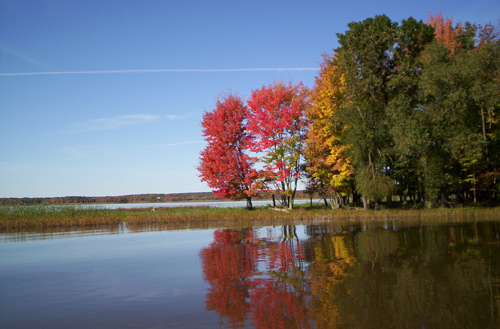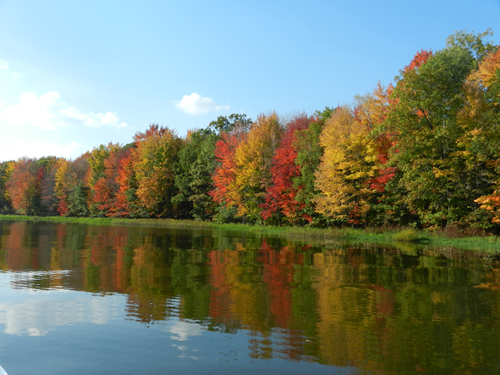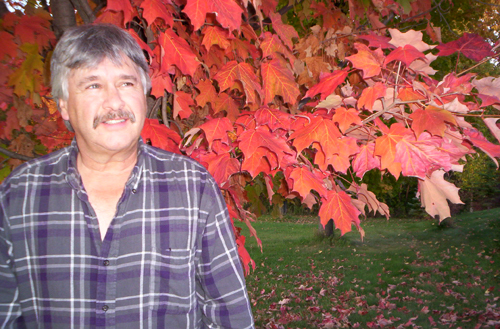Day Hikers plan on Autumn Colors

By Jim Joque
I remember from my college botany course that leaves change color in the fall due to reduced chlorophyll production as a result of less sunlight. Chlorophyll is the green pigment responsible for photosynthesis. Once chlorophyll stops producing altogether, green leaves change to colors that are characteristic of the tree type.
Moisture impacts autumn leaf color change too. According to a Wisconsin DNR report, a drought can delay the arrival of fall colors by a few weeks. A wet period during fall will lower the intensity or brightness of fall colors. And a severe frost can kill autumn leaves, turning them brown and dropping early. The best case scenario is a warm, wet spring; a summer not too hot or dry; and a fall with warm sunny days and cool nights.
The fall color phenomenon is both science and art. Plant biology and its explanation of leaf color change in autumn is the science end of things. As in observing a quality painting, the art of fall colors is in the eyes of the beholder – you and me. To savor a painter’s palette-like display of color splashed across a forest, and to appreciate the glorious glow of reds, oranges, yellows and gold dotting the landscape is truly nature’s art.
Nathaniel Hawthorne wrote, “I cannot endure to waste anything so precious as autumnal sunshine by staying in the house.” Autumn offers us the ultimate in color sensation, but only for a brief span of time. So, don’t stay in the house this fall. Select a few trails to hike, research your adventure and do some autumn sightseeing.
Selecting that special place
There are numerous places to go in the Midwest where an abundance of deciduous trees exist. Begin by checking out county and state parks and forests. National parks and forests are another option. The Ottawa and Hiawatha in Upper Michigan, Superior and Chippewa in Minnesota and Chequamegon-Nicolet in Wisconsin are national forests that always promise magnificent viewing opportunities.
In the Upper Peninsula of Michigan, I found hiking trails in the Porcupine Mountains Wilderness State Park to be a prime location. For example, witness a colorful panoramic view on the park’s Escarpment Trail overlooking Lake of the Clouds. Hiking and backpacking in the Sylvania Wilderness Area in the Ottawa National Forest rewarded me with spectacular colors both on the trees and forest floor. And other places such as trails along the Pictured Rocks National Lakeshore and along the North Country National Scenic Trail offer prime viewing of fall colors.
In Minnesota, fall colors abound along the North Shore and in any of the state parks that dot the landscape adjacent to Lake Superior, as well as on the Superior Hiking Trail. Fall colors blaze in the Northwoods around Ely and in the Boundary Waters Canoe Area.
For me at home in Wisconsin, there are many wonderful fall color locations, such as along segments of the Ice Age National Scenic Trail, in the Northern Highlands American Legion State Forest and in the state parks on the Door Peninsula. I was spellbound to find stands of tamarack (eastern larch) in forests near Antigo that were glistening like gold in the late fall.
I recommend referencing regional hiking books and guides found at bookstores and public libraries. Go online to websites of parks, forests, and trails in your area to find more locations. The opportunities are seemingly endless in the Midwest for places to hike and see fall colors.
Follow fall color reports
To find the best time for viewing fall colors, reference a fall color report. Fall color reports can be found online and sometimes on local news stations and in newspapers during the fall season. The reports provide tree color changes for a given time in a given location. For example, check out the fall color report for my area in Wisconsin at http://www.travelwisconsin.com/fall-color-report. It will provide the estimated peak color week for either September or October. For me last year near Stevens Point, peak colors were estimated to be the second week of October. The time may vary this year, given the conditions of spring, summer and fall.
To find the fall color report for your area or the area you plan to visit, check out “Fall Color Report Links” at the end of this article.
What Do I Wear?
For trail hiking, dress according to weather predictions, since autumn temperatures vary. There can be warm, cool or cold days. And the weather can change in a given day. I recommend dressing in layers.
The first layer is a wicking layer, such as breathable and nonabsorbent synthetic underwear or t-shirt, designed to wick moisture away from your body and into the next layer of clothing. The second layer is the warmth layer. Wear a quick-drying synthetic insulator that will trap your body heat, such as fleece, polyester or wool. And the third layer is the weather layer, a waterproof or water-resistant and breathable jacket or raincoat. On a warm afternoon, you can always pack extra layers in your daypack, and don them should the temperature drop.
I also recommend synthetic or synthetic-wool blend socks rather than cotton socks, since cotton does not dry easily and can bunch resulting in blisters. Also, wear boots, hikers or tennis shoes, and avoid sandals or flip-flops. Don’t forget a hat or cap and sunglasses. And bring rain gear just in case of an autumn shower.
Pack a Daypack
When going on an all-day hike, I bring along comfort and safety items in a daypack. Safety items include a small first aid kit, compass (or GPS) and map, cell phone, whistle, flashlight or headlamp, matches in a waterproof case, pocket knife, sunscreen and rain gear. One other item I bring is a space-blanket, made of NASA material that retains 80 to 90 percent of your body heat. It can be used as a wrap or tarp in the event of being lost or injured and having to spend a night in the woods. And finally, I bring two filled water bottles, and a sack-lunch or snacks.
My comfort items include a small stove with a gas canister and a tin cup should I want to warm some soup or make hot chocolate; extra socks and sweater, a hiking staff (or trekking poles), and my camera. Some people bring a compactible lightweight stool that attaches to the daypack.
Although these items may seem like a lot, altogether my pack may weigh about 10 pounds. I find it better to have a few items I may not need, than to be unprepared should a situation arise.
Tips for Your Trips-
The following is a list of suggestions that may help to make your fall color viewing more enjoyable.
– Reference a fall color report for the area you are visiting (for best time to view peak colors).
– Plan ahead (select a trail; if overnight, reserve a place to stay ahead of time).
– Check the National Weather Service for the area (go online to http://www.weather.gov ).
– Take a trail map and compass or GPS.
– Pack a daypack and carry water, lunch or snacks.
– Leave early (notice differences from morning, noon and late afternoon viewing).
– Take a camera.
– use your senses (sight, hearing, smell… take it all in).
Also plan an alternative day in the event your selected date turns into rain. However, a rainy day of fall color has its beauty too. But a sunny or partly crisp cloudy day in autumn can’t be beat.
The Wisconsin Department of Natural Resources website explains in greater detail how leaves change color in autumn. According to their report, once a tree stops producing chlorophyll, carotenoid that already exists in leaves show through and leaves become bright yellow, gold, orange and warm brown. Hickory, birch, poplar and ash are good examples.
Red color in certain trees functions differently and has to do with anthocyanins activity in the leaves that give trees bright shades of red, purple and crimson. Temperature and cloud cover in fall can make a difference in the brightness of reds. For example, several warm and sunny autumn days with cool but not freezing nights will result in a good year for red colors in trees like oaks and maples.
Learn more at http://dnr.wi.gov/education/educatorresources/fallcolors.html.
FALL COLORS REPORT LINKS
The following websites provide fall color reports and/or related information for given Midwest states. Reference them to identify the best time to go sightseeing for fall colors.
Wisconsin
www.travelwisconsin.com/fall-color-report
Minnesota
www.dnr.state.mn.us/fall_colors/index.html
www.northshorefallcolors.com/report/index.htm
Michigan
www.michigan.org/fall
Upper Michigan and Northern Lower Michigan
www.uptravel.com/fall-color-reports-56/
www.newsupnorth.com/fall/
Iowa
www.iowadnr.gov/Conservation/Forestry/Forestry-Links-Publications/Fall-Color
www.traveliowa.com/fallcolor
Illinois
extension.illinois.edu/fallcolor/updates.cfm
extension.illinois.edu/fallcolor/
National Weather Service Fall Colors Report
www.weather.gov/ilx/fallcolorsreport
US Forest Service
www.fs.fed.us/fallcolors/2015/index.shtml



